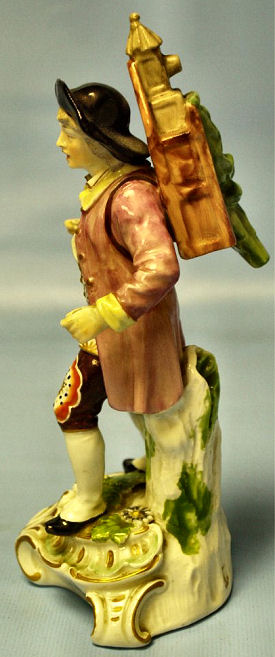|
Between art and knick-knack. part 2. Useful and decorative objects, the valuable to the worthless, the wonderful to the hideous, but always with a connection to the magic lantern.
|
||
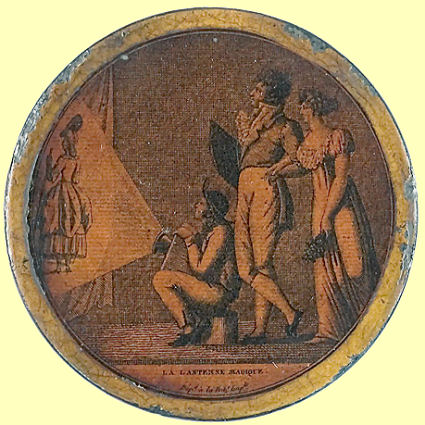 |
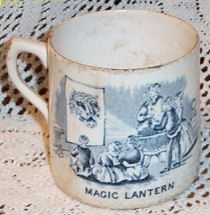
|
|
Snuff-Box with Magic Lantern. C. 1800-1820, French. Papier-mâché snuff-box with friction-fitted lid with black and white transfer-printed scene entitled 'La Lanterne Magique/Dep a la Bibe. Imple'. 3.5" diameter x 0.75" high (9 x 2 cm). |
Old pottery cup, probably for children. Made between c. 1880 and the early 1900's. There is a small maker's mark at the bottom. Two nice images adorn the cup, each covering a half of the cup's outside. The first one shows a magic lantern show at home; the other shows a small group of children and is called 'Playing at Soldiers'. |
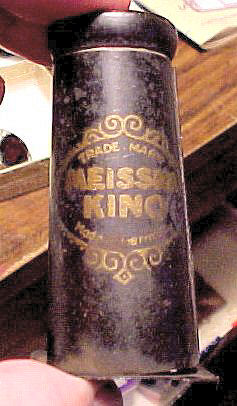 |
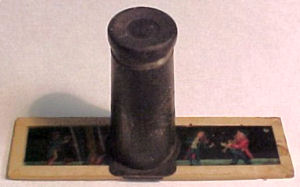 |
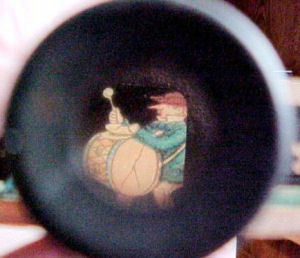 |
|
Viewer for small magic lantern slides (1½" x
5"), made in Germany by MEISSNA KINO, probably late 1800s or early 1900s. |
||
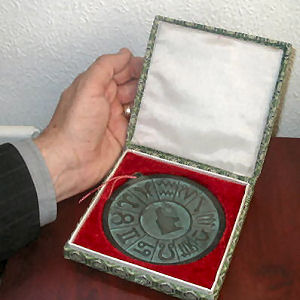 |
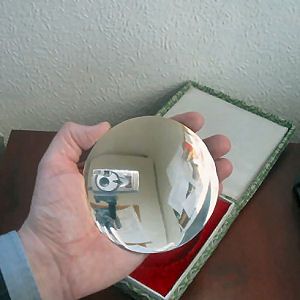 |
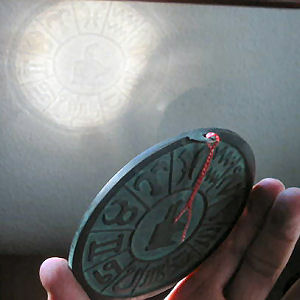 |
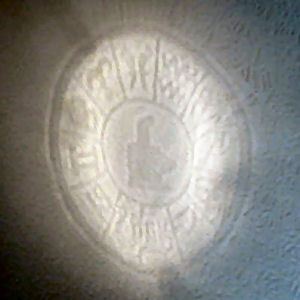 |
Magic
mirrors are an ancient Chinese optical curiosity which have mystified
western scientists for hundreds of years. In 2004, David Burder (a Fellow of the Royal
Photographic Society) demonstrated to members of the Magic Lantern
Society during a meeting held at The Magic Circle's establishment in
London, that he was able to reproduce the effect. Since then, David has
commissioned the production of a small number of magic mirrors. It is a
heavy metal disc, four inches in diameter, with the signs of the zodiac
around the edge and a phantasmagoria magic lantern in the middle. The
other side has a slightly convex, highly polished, completely smooth
"mirror" surface. When you reflect bright sunlight off the mirror side,
onto a white surface, it shows the detailed design from the back of the
mirror! |
|
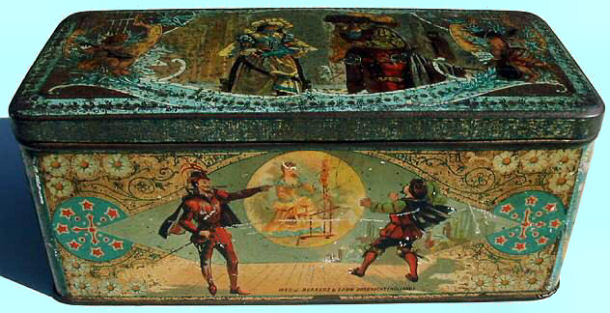 |
 |
|
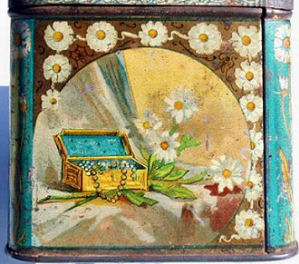 |
 |
|
|
Original
Dutch cigar tin named 'Magic lantern',
made in Dordrecht, the Netherlands, by Widow Bekkers & Sons, around 1900. Images: Lid: A knight gives a lady a gift. Faust at the right is looking at them. Front: with the help of a magic lantern Faust shows this knight the image of another woman. Back: the knight now has this new girl and Faust in the back has the girl he wanted. Sizes are 9.5 x 4.5 x 4 inches (23.74 x 11.25 x 10 cm). |
||
 |
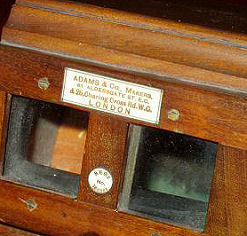 |
|
|
This elegant,
beautiful designed solid mahogany binocular magic lantern slide viewer
made by Adams & Co. London, in the second half of the 19th century is an
exciting example of Victorian craftsmanship. The viewer is c. 10" (25 cm) high. The two lenses can be moved in and out to focus. They magnify one of the two standard 3 1/4 inch square glass slides which are placed in the carrier while it is illuminated through the rear frosted glass screen. The carrier moves from side to side to view the two slides one at a time; toggles on the ends of the carrier stop it going too far. The name of the maker and registration marks are applied on the face on two small ivory panels. |
||
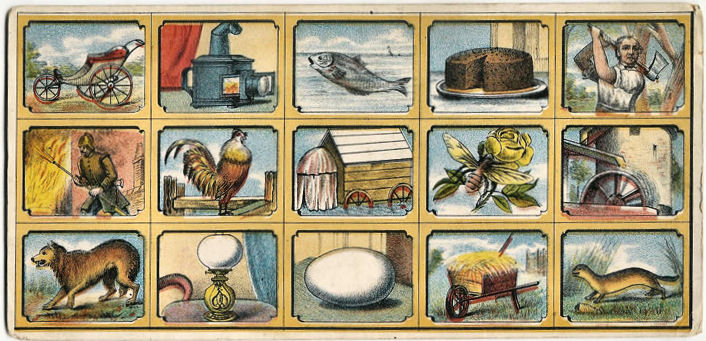 |
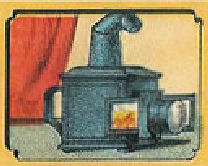
One of a
set of lotto game cards. This one depicts a simple toy magic lantern. The
cards are probably English and from c. 1880. Size: 23.5 x 11.5 cm. |
|
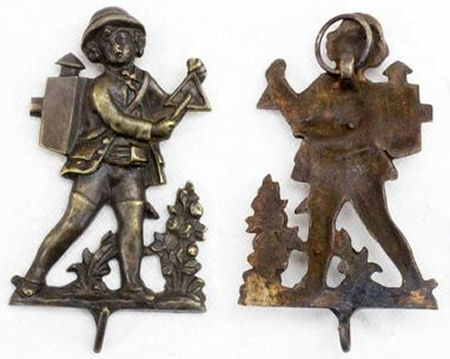 |
|
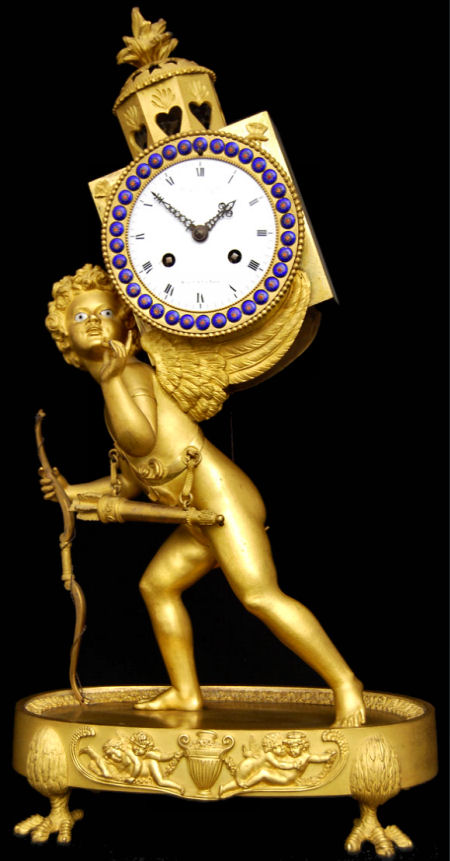 |
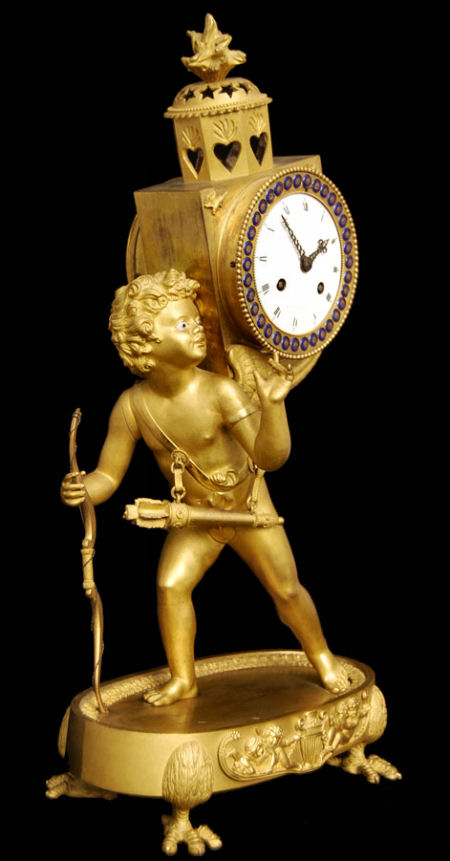 |
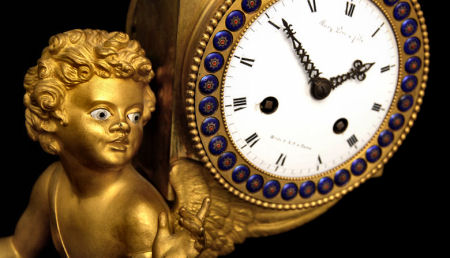 |
 |
|
Extraordinarily
beautiful mantel clock. Amor with a magic lantern on his back
travelling around the country. In his right hand a bow and hanging on his
hips a casket with arrows. Clockwork with string pendulum, striking mechanism with locking wheel and beating a bell. Special patinated hands. The slightly rounded lunette has small blue enamel rosettes around it. Dial signed with 'Musy, Pere et Fils, Hrs de S.a.S. à Turin'. Period Empire, ca 1800. Dimensions: high 47 cm, wide 24 cm and deep 13 cm. |
|
|
Source:
www.deklokkenmakervanapeldoorn.nl. |
|
 Rare porcelain figurine of an itinerant lanternist, walking from village to village with his magic lantern strapped to his back. It probably dates from about 1850 and measures 6.5 inches (16.5 cm) tall. |
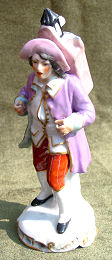
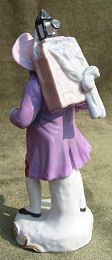
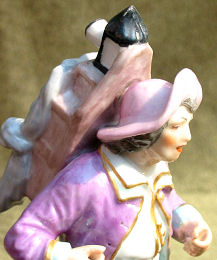 |
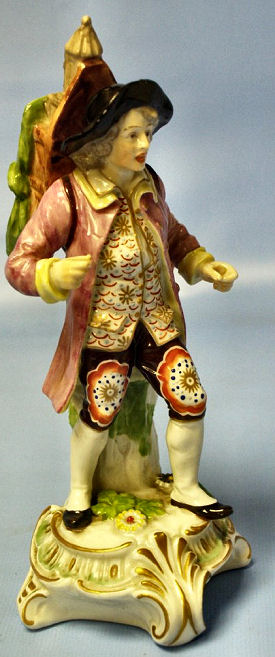 |
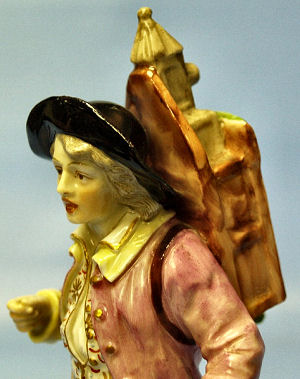 |
|
|
The same figurine from above, but now in a splendid and more detailed
version. It is made by Samson and probably dates from around 1850-1870.
It measures 7.25" (c. 18 cm) tall. |
||
|
Photographs: Martin Gilbert Antiques ltd. Staffordshire. U.K. |
||
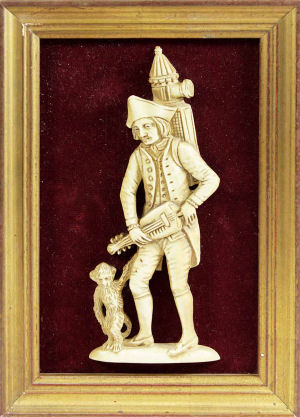 |
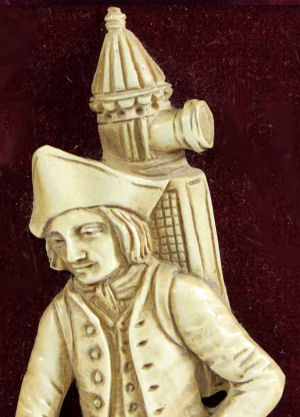 |
Le porteur de Lanterne
Magique. Charming bas-relief figurine made around 1960 from Icoryl or ivoirine (a substance that imitates ivory and is a mixture of ivory powder and resin) by François Noe after an 18th Century sculpture. It measures 12 cm high and is mounted in the original frame. Perhaps this is the little monkey from Jean-Pierre Claris de Florian's well-known fable 'The monkey displaying the magic lantern.' |
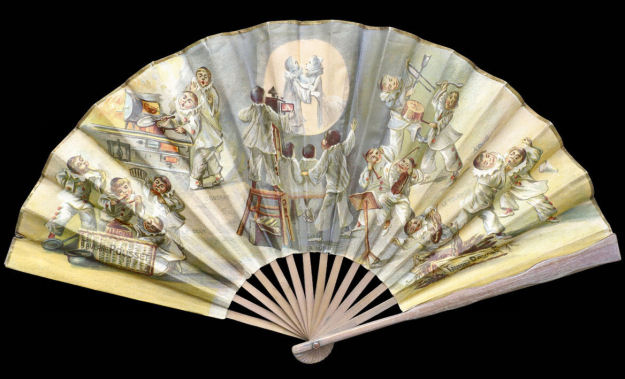 |
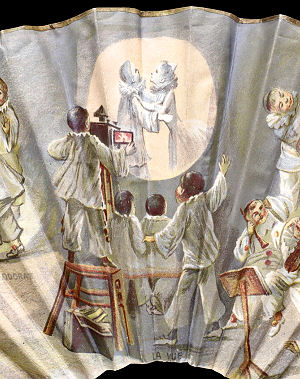 |
|
|
Beautiful fan with the image of a magic lantern
show. 1900. Rare advertising fan for LA TAVERNE ROYALE (restaurant), with representations of the five senses. The 'seeing' is illustrated by a scene with a magic lantern. Dimensions of engraving: 22 x 31 cm. |
||
 |
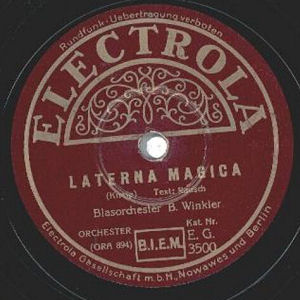 |
78 rpm record with
music by the Blasorchester B. Winkler entitled 'Laterna Magica'. On the
other side it says 'Sie hiess Marie'. Label Electrola 3500, diameter 25
cm, material shellac. |
| The Spanish company Hemisferium specializes in recreating antique scientific instruments. They build objects whose beauty and precision will surprise you. All the pieces are assembled by hand in their workshop in Madrid. | ||
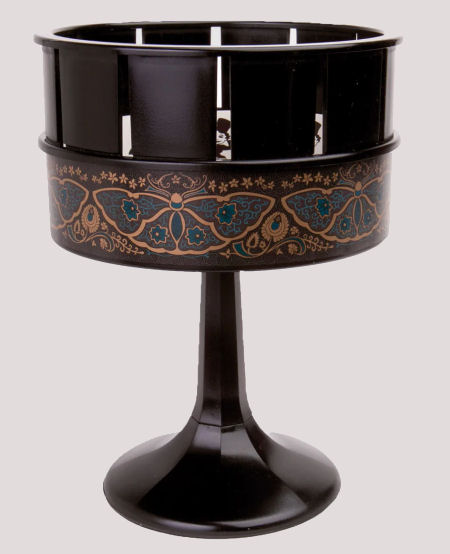 Zoetrope |
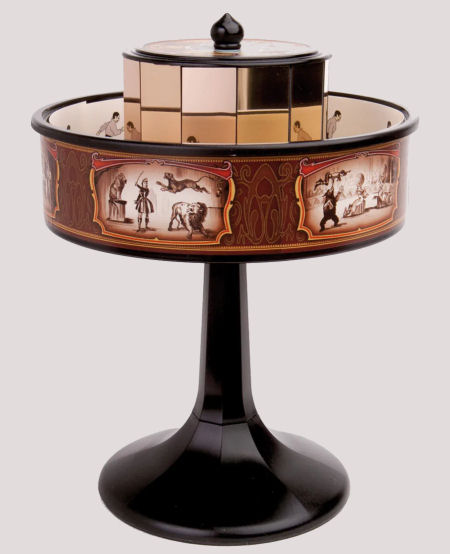 Praxinoscope |
|
|
In the
zoetrope the viewer
observes the rotating drum from the rectangular holes arranged on the
strip of the sequence of images thus observing an animation of a clear
sequence, in which the images merge and the elements come to life. Includes 20 animated picture strips. Diameter: 20cm, height:22cm. In the praxinoscope a circular drum is rotated with mirrors in the centre of the drum reflecting images drawn on strips of paper placed around it. The spectator looks over the instrument and can thus observe an animation of a clear sequence, in which the images merge and the elements come to life. This optical toy is decorated based on traditional images of the Circus of the late nineteenth century, early twentieth century. Includes 20 animated picture strips. Maximum height: 19.5cm, Diameter: 14.2cm. |
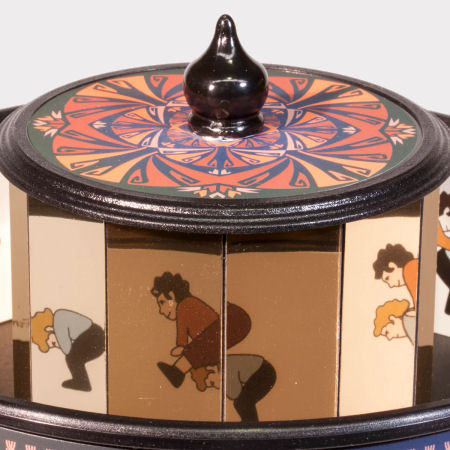 |
|
| More ....... | ||
| |
©1997-2025 'de Luikerwaal' All rights reserved. Last update: 22-06-2025. |
